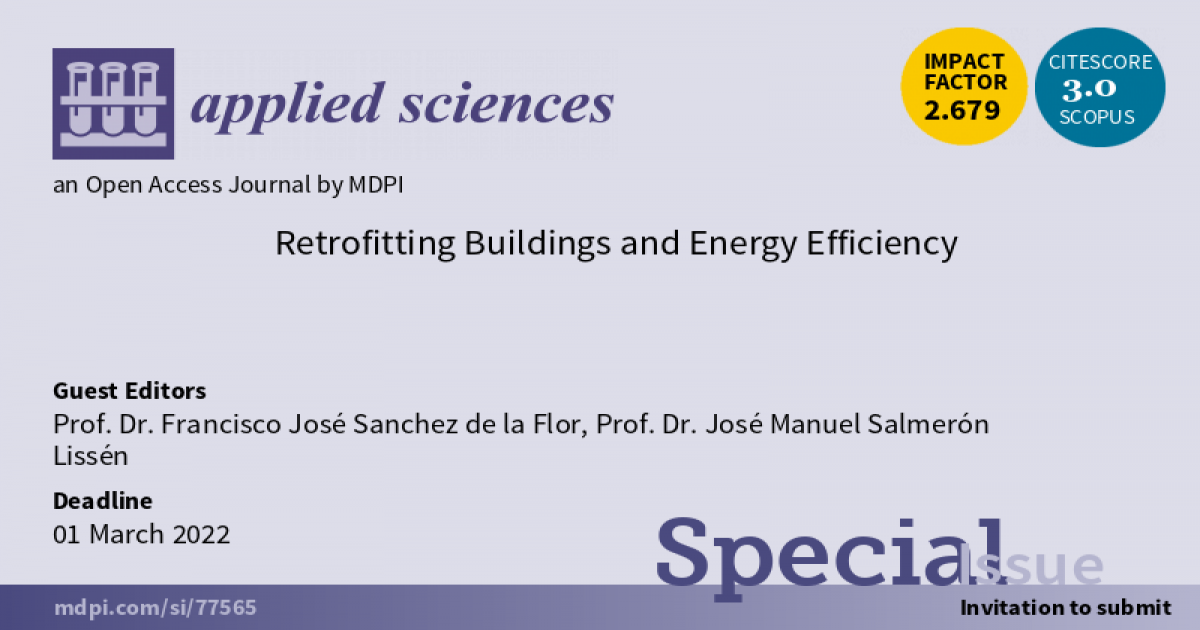Retrofitting Buildings and Energy Efficiency
A special issue of Applied Sciences (ISSN 2076-3417). This special issue belongs to the section "Environmental Sciences".
Deadline for manuscript submissions: closed (1 March 2022) | Viewed by 26636

Special Issue Editors
Interests: thermal performance of buildings; thermal comfort; natural cooling techniques; energy systems; urban climate; sustainable architecture
Special Issues, Collections and Topics in MDPI journals
Interests: energy efficiency; adaptive comfort; energy rehabilitation; energy certification of buildings
Special Issues, Collections and Topics in MDPI journals
Special Issue Information
Dear Colleagues,
Today, buildings are estimated to be responsible for approximately one-third of energy consumption in developed countries. A situation, largely due to the fact that the current building stock was built without strict thermal regulations. On the other hand, the pace of renovation of this building stock is still very slow; for example, it is estimated that in the EU it is 1% per year. All of the above means that global energy policy is aimed at reinforcing national thermal regulations and, on the other hand, activating energy efficiency promotion plans, mainly focused on building retrofitting.
The importance of strong measures to reduce energy consumption in buildings is a key point that the scientific community has been insisting on for decades. Numerous theoretical studies have been developed highlighting the energy savings that are achievable by improving the design of buildings or by the use of different technologies or materials. In addition, as new buildings demonstrating these technologies emerge, opportunities arise to experimentally quantify real savings.
The situation is still far from resolved, and new technologies and materials will be needed in the future to help reduce energy consumption in buildings. Moreover, it will still be necessary to improve the design of buildings that take advantage of the natural resources at their disposal by making them as passive as possible. In addition to these challenges also is the added difficulty of starting from an unfavourable initial situation when it comes to existing buildings.
This Special Issue aims to collect new advances in knowledge of retrofitting buildings and energy efficiency through publications on theoretical studies, numerical simulations of building energy performance, experimental measures in laboratories or even in real buildings.
Prof. Dr. Francisco José Sanchez de la Flor
Prof. Dr. José Manuel Salmerón Lissén
Guest Editors
Manuscript Submission Information
Manuscripts should be submitted online at www.mdpi.com by registering and logging in to this website. Once you are registered, click here to go to the submission form. Manuscripts can be submitted until the deadline. All submissions that pass pre-check are peer-reviewed. Accepted papers will be published continuously in the journal (as soon as accepted) and will be listed together on the special issue website. Research articles, review articles as well as short communications are invited. For planned papers, a title and short abstract (about 250 words) can be sent to the Editorial Office for assessment.
Submitted manuscripts should not have been published previously, nor be under consideration for publication elsewhere (except conference proceedings papers). All manuscripts are thoroughly refereed through a single-blind peer-review process. A guide for authors and other relevant information for submission of manuscripts is available on the Instructions for Authors page. Applied Sciences is an international peer-reviewed open access semimonthly journal published by MDPI.
Please visit the Instructions for Authors page before submitting a manuscript. The Article Processing Charge (APC) for publication in this open access journal is 2400 CHF (Swiss Francs). Submitted papers should be well formatted and use good English. Authors may use MDPI's English editing service prior to publication or during author revisions.
Keywords
- retrofitting of buildings
- energy efficiency
- energy-saving measures in buildings
- renewable energy
Benefits of Publishing in a Special Issue
- Ease of navigation: Grouping papers by topic helps scholars navigate broad scope journals more efficiently.
- Greater discoverability: Special Issues support the reach and impact of scientific research. Articles in Special Issues are more discoverable and cited more frequently.
- Expansion of research network: Special Issues facilitate connections among authors, fostering scientific collaborations.
- External promotion: Articles in Special Issues are often promoted through the journal's social media, increasing their visibility.
- Reprint: MDPI Books provides the opportunity to republish successful Special Issues in book format, both online and in print.
Further information on MDPI's Special Issue policies can be found here.






